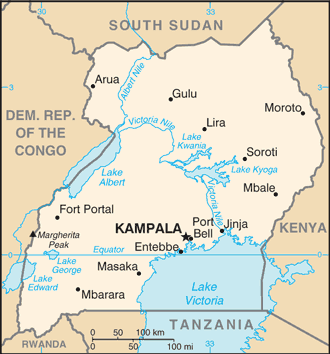Officials with the Uganda Ministry of Health have confirmed that a nine-year-old boy from Nakaseke, in central Uganda, tested positive for Crimean-Congo Hemorrhagic Fever (CCHF), according to a NTV Uganda report.

The boy is hospitalized and in isolation at Kiwoko Hospital and is recovering with treatment.
“There is no cause for alarm”, Permanent Health Secretary Dr Diana Atwine said in a press briefing Monday. “Uganda will have developed very, very strong mechanisms to deal with any epidemic”.
Sarah Opendi, the State Minister of Health said, “Results from Uganda Virus Research Institute, Entebbe from Dec. 27 tested positive for the Crimean-Congo Hemorrhagic Fever and negative for other viral Hemorrhagic Fevers like Ebola, Marburg, Rift Valley Fever and Sosuga.”
Subsequent testing reveals that the virus has cleared, according to Opendi.
Opendi says results on the death of 9-year-old Brigdet Nalunkuuma from the Uganda virus research institute Entebbe released yesterday tested negative.
LISTEN: Crimean-Congo Hemorrhagic Fever: Increasing spread predicted
According to the WHO, Crimean-Congo hemorrhagic fever is a widespread disease caused by a tick-borne virus (Nairovirus) of the Bunyaviridae family. The CCHF virus causes severe viral hemorrhagic fever outbreaks, with a case fatality rate of 10–40%.
CCHF is endemic in Africa, the Balkans, the Middle East and Asian countries south of the 50th parallel north – the geographical limit of the principal tick vector. The hosts of the CCHF virus include a wide range of wild and domestic animals such as cattle, sheep and goats.
Animals become infected by the bite of infected ticks and the virus remains in their bloodstream for about one week after infection, allowing the tick-animal-tick cycle to continue when another tick bites. Although a number of tick genera are capable of becoming infected with CCHF virus, ticks of the genus Hyalomma are the principal vector.
LISTEN: Pandemic vs epidemic: What’s the difference and why does it matter?
The CCHF virus is transmitted to people either by tick bites or through contact with infected animal blood or tissues during and immediately after slaughter. The majority of cases have occurred in people involved in the livestock industry, such as agricultural workers, slaughterhouse workers and veterinarians. Human-to-human transmission is possible.
Related:
- Somalia: Fascioliasis blamed on goat deaths in Middle Shabelle
- Listeriosis: ‘This is the largest documented outbreak South Africa has ever experienced’
- Cholera vaccination campaign begins in Lusaka: ‘One of the worst outbreaks in years’
- Meningitis in Africa: ‘The risk of imminent large-scale epidemics is dangerously high’




When I was a student worked at very small but very amazing company who made all Vector born diseases very simple testing assay . Name of that company was “Vector test systems , Inc. ” It was at Thousand Oaks, California .
Hi Jackie, I don’t believe VecTOR test (thats their current name) have developed assay for CCHF in vectors. But you are correct, they are a great resource for DENV, RVFV, Leishmania major and i believe Chikungunya tests in arthropods